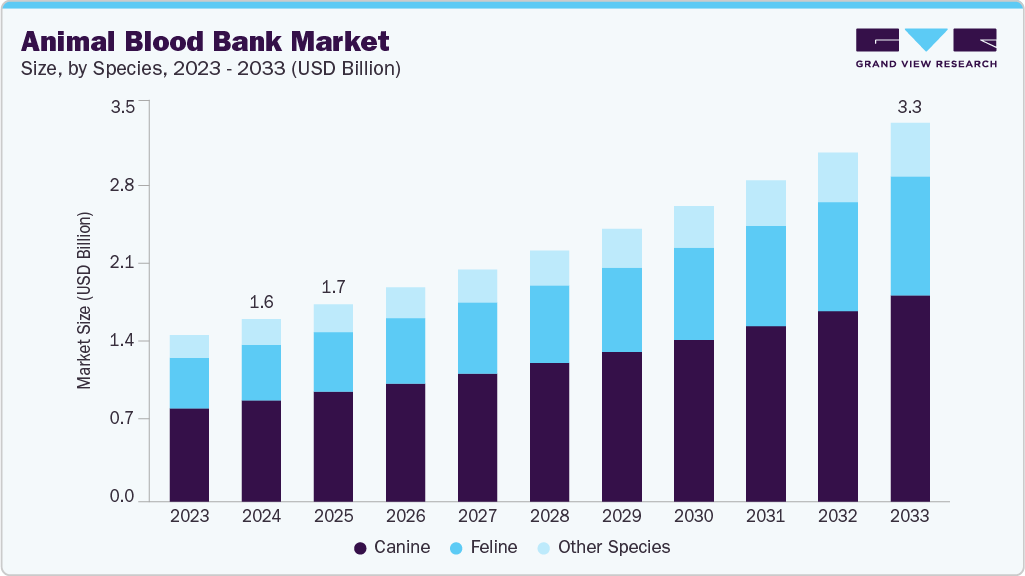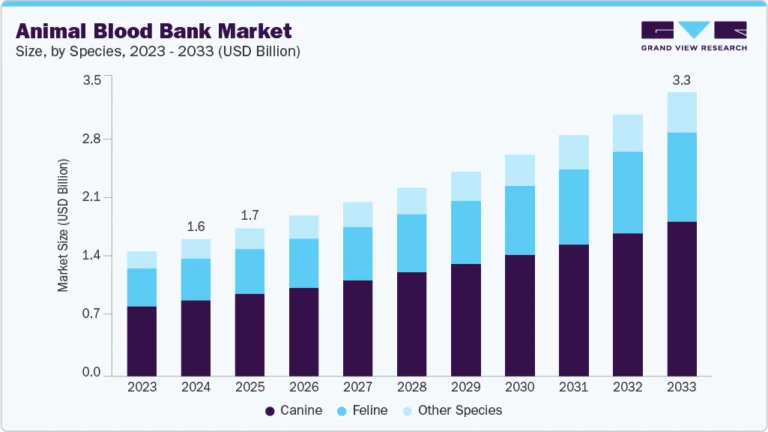Animal Blood Bank Market Summary
The global animal blood bank market size was estimated at USD 1.56 billion in 2024 and is projected to reach USD 3.25 billion by 2033, growing at a CAGR of 8.5% from 2025 to 2033. The primary factor driving the market is the rising demand for animal blood products, fueled by increased use of transfusions in emergency and specialty veterinary care, expanding blood banking infrastructure, and greater pet owner participation in donor programs.
Key Market Trends & Insights
- North America animal blood bank market held the largest share of 50.7% of the global market in 2024.
- The animal blood bank industry in India is expected to grow at the fastest rate over the forecast period.
- By product, the packed red blood cells segment held the largest global market share in 2024.
- By species, the canine segment accounted for the largest revenue share in 2024.
- Based on type, the standalone segment holds the largest share in 2024.
Market Size & Forecast
- 2024 Market Size: USD 1.56 Billion
- 2033 Projected Market Size: USD 3.25 Billion
- CAGR (2025-2033): 8.5%
- North America: Largest market in 2024
- Asia Pacific: Fastest growing market
A rising demand for animal blood products is driving the industry. Advances in veterinary care and changing pet owner expectations have made blood transfusions an increasingly essential component of treatment protocols in emergency and specialty settings.
Clinical cases highlight this trend. At leading veterinary institutions, transfusions are no longer rare interventions but critical, often repeated procedures that can determine survival outcomes. One such case involved a canine patient at Tufts University. In June 2025, the canine patients required multiple units of blood products, including whole blood, red blood cells, and plasma, to recover from severe internal hemorrhage. Such examples highlight how access to readily available blood supplies is becoming indispensable in modern veterinary medicine.

However, the demand has begun to surpass the supply. Veterinary practitioners consistently report shortages of blood products, driven by several factors such as the growing prevalence of advanced interventions, the expanding availability of specialty and emergency services, and the increasing willingness of pet owners to invest in life-saving treatments. As a result, clinics are turning to structured blood banking systems rather than relying solely on external suppliers. Many hospitals are now working to establish internal donor programs, with some aiming to source a substantial proportion of their transfusion needs from within their networks.
Awareness and donor participation remain critical to meeting this demand. While many pet owners are unaware that dogs and cats can be blood donors, studies show that most express willingness once informed. This has led to increased emphasis on outreach initiatives, owner education, and donor incentive programs, all…
Read More: Animal Blood Bank Market Size, Share



